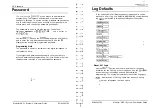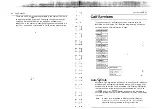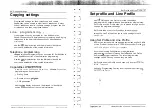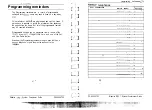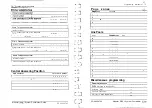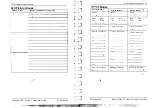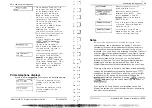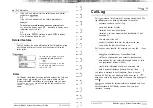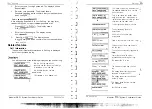
82 Using
features
One button access
You can program most
feature codes onto telephone
memory buttons so that you can use the feature by pressing a
single button. See the procedures in the Feature programming
section,
Whenever the instructions tell you to enter a feature code, you
can do so either by pressing the buttons shown in the feature
description or by pressing a memory button on which the feature
code has been programmed. You can also enter a telephone
number by pressing an
button, rather than entering it
manually.
Canceling a feature
Some features change the way your telephone works. To make
your telephone work normally again you must cancel the feature.
To cancel a feature, press
then
and the feature
code. For example, to
cancel
Call Forward, which you activate by
pressing
press
If a feature code is programmed onto a memory button, you may
be able to cancel the feature by pressing the memory button
while the feature is active.
If you change your mind in the middle of using a feature, you can
back out pressing
or
Se aware that pressing
disconnects any active or held call.
Telephone
Because the
Telephone does not have any line buttons it
sometimes works slightly differently from other
telephones. Where other telephones may require you to select a
line button to answer a call, on the M7100 Telephone you simply
pick up the receiver.
other telephones require you to
select a line button to’
a call off hold, you press [Hold) on
the
Telephone. The
Telephone cannot have a
button. You will find special instructions for the M7100
Telephone in some feature descriptions.
Modular DR5.1 System Coordinator Guide
P O 6 4 2 6 4 7 0 2
Answering the telephone
Answering the telephone
Answering
telephone can receive many different types of calls.
Your telephone’s display tells you what type of call you are
The usual way to answer a call is to pick up the
there are several other possible methods.
depending on how your system is set up and the type of call that
i s r i n g i n g .
Callback
When
you direct a call you have answered to another telephone,
the system monitors the
to make sure someone answers it. If
no one answers a call within a programmable length of time, the
system directs it back to you. Callback generates a variety of
displays. Most occur after a programmable delay and are
this section. Some occur immediately, if the telephone to which”
you are directing a call is
out
of service or otherwise unavailable.
These are listed with the descriptions of the features in which
they occur.
.
Delayed
Transfer (DRT)
If no one answers a call within a programmable length of
the system transfers the call to the Prime telephone.
Call Display information
If you have
to Call Display services from your local
telephone company, one line of information about an external
caller is displayed after you answer. If your telephone has been
programmed to receive Call Display information automatically4
that information is shown before you answer. Depending on the
setting
Programming and the external
i n f o r m a t i
n u m b e r i
a v a i l a b l e , e i t h e r t h e c a l l e r ’ s n a m e o r t e l e p h o n e
d i s p l a y e d .
When you transfer an external call to another
user, this
information is displayed on the recipient’s telephone.
P O 6 4 2 6 4 7 0 2
Modular DR5.1 System Coordinator Guide




